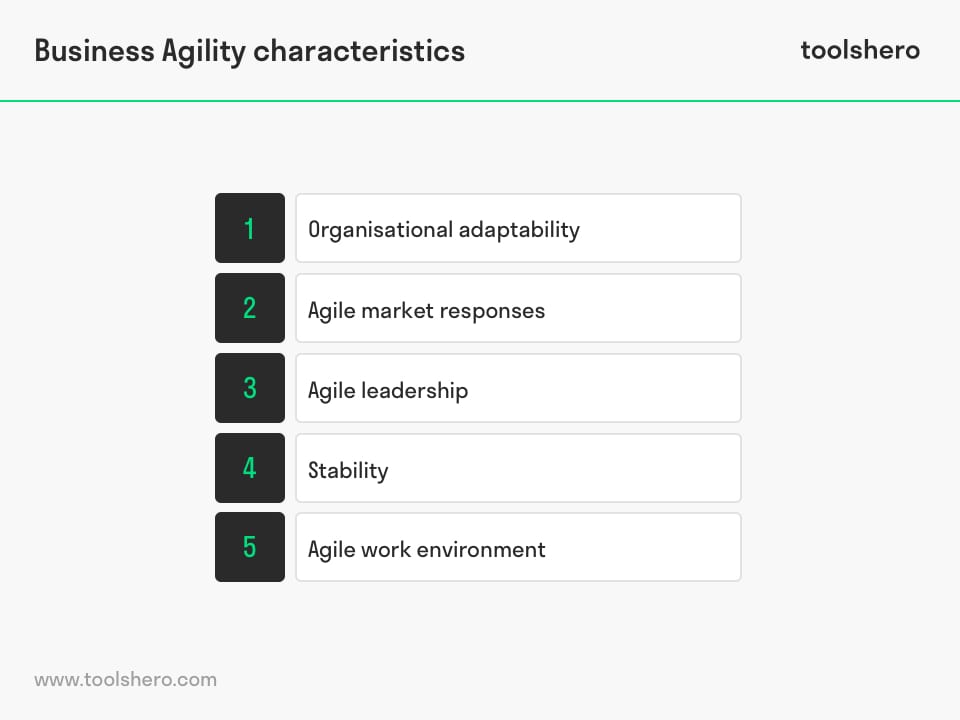Business Agility explained

Business Agility: this article provides a practical explanation of Business Agility. Next to what it (definition) is, this article also the characteristics, business agility versus bureaucracy, the benefits and a short summary. After reading, you’ll have a basic understanding of this management concept. Enjoy reading!
What is Business Agility?
Definition of Business Agility
Business Agility can be defined as the ability of an organisation to anticipate change early; the ability to quickly shift its business system. From a financial perspective, business agility is about responding to changing market or environmental factors in a way that is both productive and cost efficient.
It also means responding quickly and flexibly to customer demands, increasing cost effectiveness without endangering quality, and maintaining a competitive edge.
Innovation is the key to maintaining a competitive edge. Companies who don’t innovate and instead rely on tried methods, often fall quickly behind compared to the competition because they can’t adapt fast enough.
Business Agility is a well-known concept that organisations use to manage their resources in flexible and responsive ways. It is a very different concept than bureaucracy, and also involves a different corporate culture.
The benefits for organisations that are business agile include capitalising on new business opportunities such as new distribution channels or supply chain management to lower costs or increase revenue.
Business Agility is based on various theories written by project management pioneers. These ideas and theories originated in the early nineties, most likely in the United States.
Business Agility Characteristics
Business Agility can be explained using the following elements:

Figure 1 – the characteristics of Business Agility
1. Organisational Adaptability
Flexible organisations use various advanced processes and tools to be able to successfully respond to the market. In general, an agile organisation consists of competent and confident team players, guided by leaders with a vision and the ability to make the system coherent.
Agile organisations are based on continuously learning from experiments and other tests, and they use an open style of internal communication. In many ways, agile organisations are the exact opposite of bureaucratic organisations.
2. Agile Market Responses
Business Agility is about quickly and flexibly serving the customers’ needs, without sacrificing quality. It’s about combining speed and effectiveness.
It’s always possible to work quicker, but that speed has to be combined with efficiency, so employees spend less time on things that don’t create value for consumers. Optimising the efficiency of the supply chain is also part of this.
3. Agile Leadership
An agile organisation is managed by managers who have the ability to look at situations from different perspectives.
They quickly assess the situation and take appropriate and effective measures. Agile leadership focuses on effective, small teams and successful collaborations.
4. Stability
On the one hand, business agility consists of a dynamic organisation as described above. On the other hand, it requires a stable foundation; a platform.
It works like a stable backbone for the organisation, an anchor point with a focus that does not shift in a changing environment. A startup can be agile without having much stability, but when that same organisation starts to grow, it can’t remain agile if it doesn’t have stability.
5. Agile Work Environment
An agile work environment is one in which people work together quickly, seamlessly, and coherently. It also means that employees can work from home or on the road.
Everyone determines where, when, and how they work, and what they will be doing exactly. Several studies have shown that this approach does not harm productivity. An agile work environment is flexible and is supported by technology, IT in particular.
A flexible work environment and a proper balance between work and private life are more important to millennials than a high salary. They also feel more at home when the ambience is personal and informal, and they want individual needs to be listened to.
Some employees need room for personal matters, while others prefer to work from home to avoid long commutes or for other reasons.
It’s important to offer this option if possible. There are several ways to make working from home a possibility. Examples are mobile work applications, video conferencing, and a digital workplace.
Business Agility versus Bureaucracy
There are a number of significant differences between an agile organisation and bureaucratic organisation.
The difference that stands out most is the use of flexible positions and roles in agile organisations. Organisational structures in an agile organisation will be able to adapt more quickly and more easily to changing business conditions than traditional, slow, bureaucratic companies. This results in a greater opportunity for the agile business to gain a competitive advantage.
Agile organisations don’t focus on a long-term competitive advantage. They focus on a hyper-sensitive and quickly changing market and strive to gain a temporary competitive edge.
Typical for agile businesses is capitalising on an idea or product for a certain period and then easily replacing it when it’s no longer commercially appealing.
Finally, agile organisations employ individuals who strive for professionalism and quality. They work hard to achieve a certain level of competence and are driven by knowledge of new fields in order to develop and expand expertise.
The difference is that they don’t specialise to only work in one particular area, as you see in traditional, bureaucratic organisations.
Business Agility Benefits
Business Agility has been recognised as an effective business strategy to quickly respond to market changes. However, not all businesses that could, actually focus on organisational agility. It has the following benefits:
- Better edge over the competition
- Higher customer satisfaction and retention
- Higher employee productivity
- Lower employee turnover
- Reduced costs
- Less time required to respond to opportunities
Now it’s your turn
What do you think? Are you familiar with this explanation of business agility? Do you see business agility in your own work environment? What are some of the advantages of flexibility and an open organisational structure in your opinion? Do you have any tips or additional comments?
Share your experience and knowledge in the comments box below.
More information
- van Oosterhout, M. M. (2010). Business agility and information technology in service organizations (No. EPS-2010-198-LIS).
- Doz, Y. L., & Kosonen, M. (2010). Embedding strategic agility: A leadership agenda for accelerating business model renewal. Long range planning, 43(2-3), 370-382.
- Hugoson, M. Å., Magoulas, T., & Pessi, K. (2008). Interoperability strategies for business agility. In Advances in enterprise engineering I (pp. 108-121). Springer, Berlin, Heidelberg.
- Overby, E., Bharadwaj, A., & Sambamurthy, V. (2006). Enterprise agility and the enabling role of information technology. European Journal of Information Systems, 15(2), 120-131.
How to cite this article:
Janse, B. (2019). Business Agility. Retrieved [insert date] from Toolshero: https://www.toolshero.com/management/business-agility/
Original publication date: 07/17/2019 | Last update: 11/17/2023
Add a link to this page on your website:
<a href=”https://www.toolshero.com/management/business-agility/”>Toolshero: Business Agility</a>












